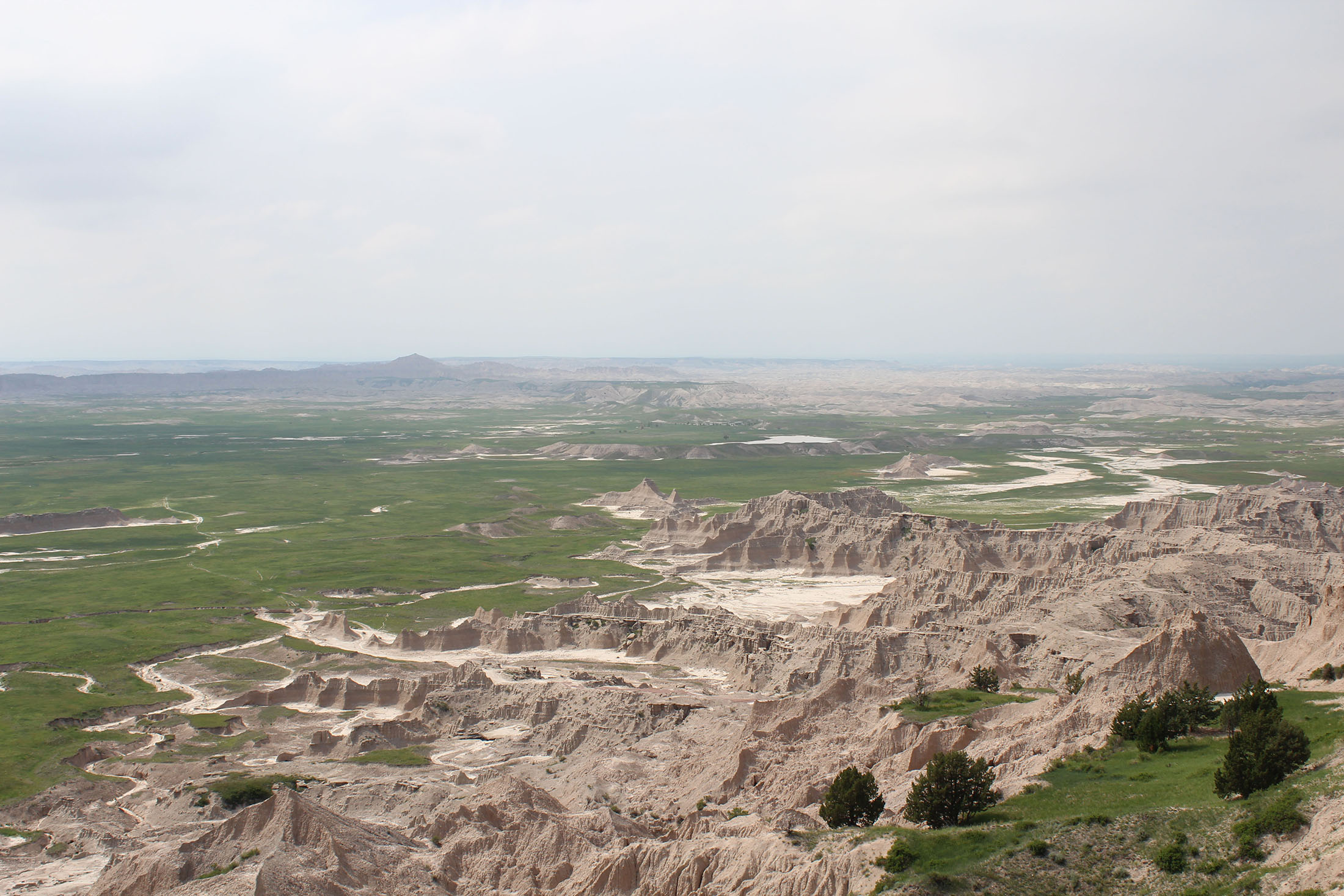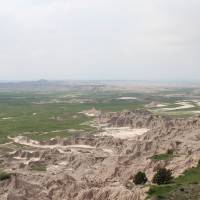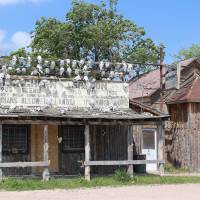Buffalo stroll undisturbed, pausing occasionally to wallow in the grass and caked dirt, while prairie dogs yip intermittently as they dive into their holes and pop out again to survey the landscape. This northern stretch of Badlands National Park, known as Sage Creek Wilderness, is what the northern Great Plains used to look like.
Several kilometers away, in the park's 54,000-hectare South Unit, located on the Pine Ridge Indian Reservation, the scene is more barren. The U.S. Army forced more than 800 Oglala Sioux families to leave their homes in the area in 1942 so that part of the reservation could be turned into a bombing range.
The land has partially recovered, but the bison have yet to return.
That could soon change. The Oglala Sioux and the U.S. National Park Service are drafting legislation to create the first tribal national park — giving the tribe the right to manage and operate the lands — in an effort to bring buffalo back to the grasslands where they roamed long before human settlement.
These steps would reshape only a portion of the Great Plains, a landscape that has been transformed by cornfields, highways and big-box stores. But for the Oglala Sioux, the wildlife that has defined their tribe and the region's ranchers, it is a chance to reclaim an area that served as a crucible for the nation's economic and political expansion in the 1800s.
"Our buffalo are going to be coming back to our country," Ruth Brown, an Oglala Sioux tribal council member who is helping draft the legislation to establish the new park, said in an interview. The group envisions a herd of more than 1,000 animals to ensure it has sufficient genetic diversity.
Tens of millions of bison used to range freely in North America before they were almost wiped out in the late 1800s. The American Bison Society disbanded in 1935 with the understanding it had saved the species by placing 20,000 of the animals in conservation herds. There are now an additional 400,000 or so being raised in the United States and Canada for meat production.
But those numbers are not enough for the buffalo to reclaim their traditional role in the ecosystem, especially because even those conservation herds amount to what buffalo herder Duane Lammers calls "islands," in circumscribed areas. Free-roaming bison provide habitat for grassland birds and other animals by grazing intermittently, leaving the grass at different heights. Cattle ranching, by contrast, leaves the grass at a more uniform level.
The Wildlife Conservation Society relaunched the American Bison Society in 2005, and a coalition of tribes, environmentalists and ranchers have been working to bring them back to areas where there is enough available land.
"We're in a sort of a renaissance, where conservation groups are realizing it needs to happen on a larger scale," said Dennis Jorgensen, a biologist and northern Great Plains program officer for the World Wide Fund for Nature.
The Badlands — where sediment deposits have been eroded by wind and water over millions of years — is an ideal setting for buffalo to make a comeback. Less suitable for agricultural development than other parts of the Great Plains, the federal Resettlement Administration started buying up ranches and farms in 1934 that failed during the Dust Bowl. The government ultimately bought more than 4 million hectares. Nearly 250,000 of them became the Buffalo Gap National Grasslands, west of the Pine Ridge Indian Reservation and the national park.
"It's just a biologist's dream, in terms of intact prairie grasslands," said Trudy Ecoffey, senior wildlife biologist for the Oglala Sioux Parks and Recreation Authority, as she gazed out at the dry, largely uninhabited terrain of Badlands' South Unit.
In addition, a handful of nonprofit organizations and entrepreneurs are willing to invest in the land to put it off-limits to development. Dan O'Brien, who owns a ranch just west of Badlands National Park, founded a buffalo products company and a nonprofit group that brings a mobile slaughtering unit to individual reservations, making it affordable for tribes to sell a few bison at a time.
O'Brien has partnered with a Boston venture capitalist to buy land from area ranchers to ensure it remains undeveloped. Despite the fact that his company, Wild Idea Buffalo, sells grass-fed meat to customers in all 50 states, he said that "buffalo is not our product" . . . (it) "is a tool" to bring back the prairie.
For the Oglala Sioux, who often describe buffalo in more ethereal terms, the effort to gain full control of Badlands' South Unit and repopulate it with bison has been fraught with tension. The National Park Service signed a memorandum of agreement in 1976 with the tribe to establish how it would operate the South Unit. Badlands National Park Superintendent Eric Brunnemann said the original plan was "problematic" because it failed to recognize the fact that the Oglala Sioux tribe is "its own country. . . . This is a government-to-government relationship."
Monica Terkildesen, who worked on the project for years as an employee of the tribe's parks and recreation authority, said: "When I started this, I was all radical. I thought: 'We didn't need the National Park Service. Let's get the land back and let's move forward on this.' "
But after attending public meetings, Terkildesen said, she realized she was in the minority. "I had to listen to what the public was saying: 'We want a tribal national park,' " she said.
Still, even though it makes sense from an ecological and economic perspective, reintroducing buffalo poses a political challenge because some Oglala Sioux own cattle-grazing permits in the area, including on the reservation. On June 11, the tribal council voted to phase out all cattle leases on the South Unit by Oct. 31, 2015.
"It was a hard sell, because we raise cows. That's what we do," said Terkildesen, who continues to work on the park project and attended the council meeting.
The push to bring back the region's native species — including black-footed ferrets as well as swift foxes and bighorn sheep — has been buoyed by the fact that interest in Native American traditions has surged among Oglala Sioux on the reservation.
More tribal members are participating in sweat lodges and sun dances, aware that they are losing their connection to the past. The tribe also raises a small herd of bison elsewhere on the reservation for meat, but members say that is not the same as having them roam on parkland.
"Our land here is diminishing, our culture is subsiding," said Enos Poorbear, a supervisor at the South Unit's White River Visitor Center, adding that creating a tribal national park would change that. "For the first time since the 1800s, it means we would be interpreting our history."
Although the Park Service issued a record of decision last year outlining how the tribe would take control of the South Unit, obstacles remain. A working group hopes to draft legislation by the end of the year, but it will have to make it through Congress. South Dakota Sen. Tim Johnson, a Democrat, is the only member of the state's three-person delegation to endorse the idea.
The South Unit gets less than one-tenth of the nearly 1 million visitors who flock to the North Unit of the park each year, raising questions about how the new park will support itself financially. And some of the native species in the area, including prairie dogs, hard hit by flea-borne sylvatic plague, continue to struggle.
But Brunnemann, the park superintendent, said "the science and the economics have come together" where the return of bison could also make the tribal park financially achievable.
"People want to come to prairie. They want to see bison on the land. All the pieces had to fall into place. Honestly, this could happen — it's just amazing to me," he said.




















With your current subscription plan you can comment on stories. However, before writing your first comment, please create a display name in the Profile section of your subscriber account page.